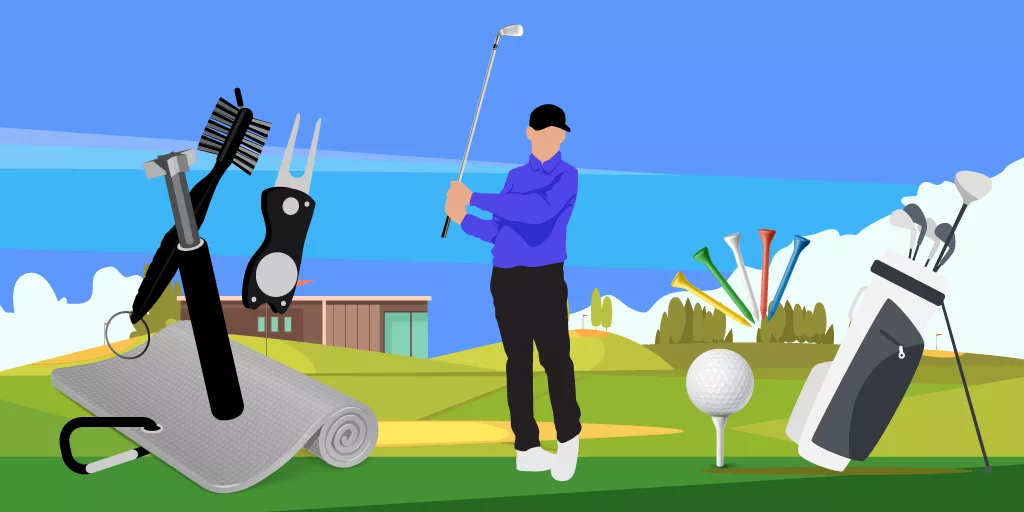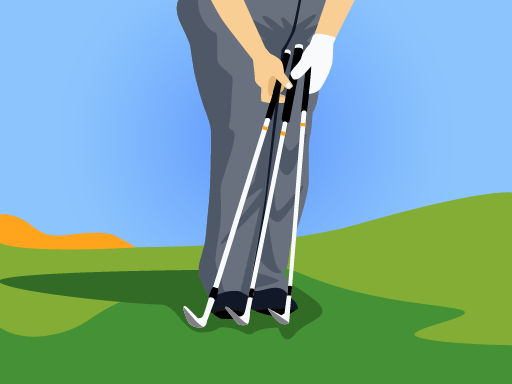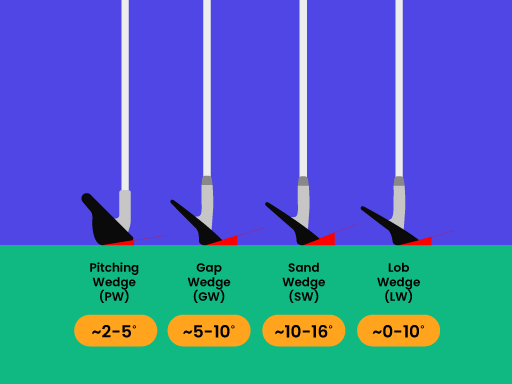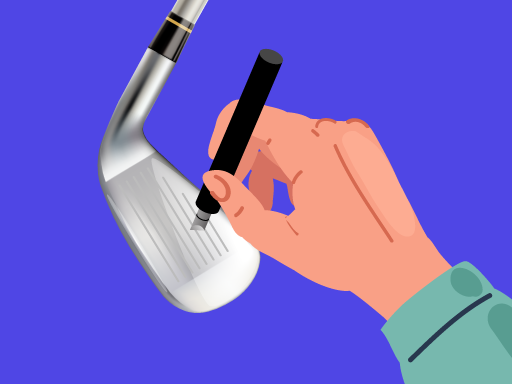
Golf is a game of precision and finesse, and having the right set of clubs can make all the difference in your game. Wedges, in particular, are a key component of any golfer's bag, whether you're a seasoned pro or just starting out. So, let's dive into the world of wedges and find out why they're such an important part of your golf game!
Understanding Wedges and Their Purpose
Wedges are clubs specifically designed to help golfers play short shots around the green. These clubs are characterized by their high lofts, which create a lot of backspin on the ball, making it stop quickly on the green. Whether you're trying to get out of a bunker, chip onto the green, or make a tricky up-and-down, wedges are the tool you need to get the job done.

Different Types of Wedges
There are several types of wedges that you'll find in a golfer's bag, each designed to perform a specific task. Here's a quick rundown of the most common wedges:
- Pitching Wedge (PW): This is typically the highest-lofted club in a golfer's iron set, and it's ideal for making full swings on the green or playing short approach shots.
- Gap Wedge (GW): This wedge fills the gap between your pitching wedge and your sand wedge and is often used for medium-length shots around the green.
- Sand Wedge (SW): As the name implies, this wedge is designed to help golfers get out of bunkers. With its wide sole and high loft, it allows golfers to hit a high, soft shot that will stop quickly on the green.
- Lob Wedge (LW): This is the highest-lofted wedge in a golfer's bag and is used for making short, high shots that will stop quickly on the green.
Why Wedges are Essential for Your Golf Game
Having a set of wedges in your bag is essential. Not only do they help you play short shots around the green, but they also give you the ability to get out of tricky lies and get up and down when you miss the green. So, don't be afraid to invest in a good set of wedges – they'll be some of the best clubs you ever buy!
Types of Wedges: Navigating the Different Clubs in Your Golf Bag
Pitching Wedges: Your Go-To Short Game Weapon
Pitching wedges often labeled PW on your club, are typically the shortest and most versatile wedge in your bag. Designed to help you get out of tight spots and execute precise, high-flying shots, the pitching wedge is a must-have for any recreational golfer.
Gap Wedges: Bridging the Gap between Irons and Wedges
Gap wedges, also known as approach wedges, are designed to fill the gap between your irons and your sand wedge. With slightly more loft than your irons, the gap wedge is perfect for those medium-distance shots that require a bit more height and spin.
Sand Wedges: Mastering the Bunker Game
Sand wedges, labeled as SW on your club, are the essential tool for getting out of sand bunkers. With a wide sole and a lot of loft, sand wedges help golfers blast their way out of bunkers and onto the green. Don't let a bunker shot intimidate you - with a sand wedge in your bag, you'll be ready to tackle any sand trap that comes your way.
Lob Wedges: The High Flyer
Lob wedges, often labeled as LW on your club, have the highest degree of loft and are perfect for those high, soft shots around the green. Whether trying to execute a delicate flop shot or get over a tree, the lob wedge is your secret weapon for mastering the short game.
Specialty Wedges: The 60-Degree Wonder
Specialty wedges, like a 60-degree wedge, are designed for those truly unique shots. With a steep degree of loft, these wedges can help you get out of tight spots, execute high, soft shots, and add a little creativity to your short game. Whether you're a seasoned pro or a recreational golfer, a specialty wedge is a great addition to your bag.
Wedge Loft and Bounce: The Secret Sauce for Better Short Game Shots Making

Explanation of Loft
Loft refers to the angle of the club face relative to the ground. It is the primary factor that determines the height of the shot. Higher lofted wedges will create higher shots and lower lofted wedges will create lower shots. Pitching wedges typically have a loft of around 44-46 degrees, gap wedges are around 50-52 degrees, sand wedges are around 56 degrees, and lob wedges can have a loft of 60 degrees or higher.
Explanation of Bounce
Bounce refers to the angle between the club's sole and the ground. It is the angle that helps the club glide through the turf and prevents digging into the ground. A higher bounce angle helps the club to glide through the rough and bunkers, while a lower bounce angle is better for tight lies on the fairway or in the rough.
Understanding Loft and Bounce in relation to different types of shots
The combination of loft and bounce can greatly affect the outcome of a shot. Higher lofted wedges with higher bounce are great for shots that require more height, such as shots out of the sand. Lower lofted wedges with lower bounce are better for shots that require more roll, such as shots from the fairway or rough.
How to choose the right Loft and Bounce for your wedges
Choosing the right loft and bounce for your wedges depends on your personal swing and shot preferences, as well as the types of courses and conditions you play in. A good starting point is to have a pitching wedge with a 44-46 degree loft and a moderate bounce, a gap wedge with a 50-52 degree loft and a moderate bounce, a sand wedge with a 56-degree loft and a high bounce, and a lob wedge with a 60-degree loft and a high bounce. You can also consult with a club fitter to determine the best options for your game.
Wedge Selection: Finding the Right Fit for Your Game
Factors to Consider When Selecting Wedges
When it comes to selecting the right wedges for your golf bag, there are several factors to consider. These include your skill level, swing type, and preferred shot styles. For example, a beginner golfer may benefit from a higher lofted wedge with a wider sole and more bounce, while a mid-handicapper may prefer a lower lofted wedge with less bounce for better control and versatility.
Matching Your Wedges to Your Irons
It's also important to consider the set of irons you already have when selecting wedges. Ideally, you want to choose wedges that complement your iron set, filling in any gaps in your yardage coverage. This way, you can be confident in your ability to execute a variety of shots with ease and accuracy.
Explanation of Wedge Sets
In addition to individual wedges, you may also consider purchasing a wedge set. These sets typically include a pitching wedge, gap wedge, sand wedge, and lob wedge, and are designed to offer comprehensive yardage coverage for all types of shots. When selecting a wedge set, it's important to choose one that fits your skill level and swing type and matches your iron set for optimal performance.
Wedge Techniques: Mastering the Short Game
Overview of Wedge Shot Types
Wedge shots are an integral part of the short game and can make or break a round of golf. There are several types of wedge shots, including:
- Pitching: A shot that covers a short distance with a high trajectory and maximum stopping power.
- Chipping: A shot used for short distances around the green, typically when the ball is close to the putting surface.
- Sand Shot: A shot used from a sand bunker, usually to get out of the sand and onto the green.
- Lob Shot: A high, soft shot used to clear a hazard and land the ball softly on the green.
Techniques for Each Wedge Shot Type
Pitching
- Stance and ball position: Stand with your feet shoulder-width apart and position the ball slightly forward of center in your stance.
- Swing path and angle of attack: Swing the club upward and make solid, ball-first contact.
- Follow-through and finish: Finish the shot with a high follow-through, keeping the clubhead above your shoulder line.
Chipping
- Grip and stance: Use a neutral grip and stand with your feet shoulder-width apart.
- Swing path and tempo: Swing the club on a slightly descending path, maintaining a smooth and controlled tempo.
- Follow-through and finish: Finish the shot with a short, smooth follow-through, keeping the clubhead low to the ground.
Sand Shot
- Stance and ball position: Stand with your feet shoulder-width apart and position the ball back in your stance.
- Swing path and angle of attack: Swing the club on an upward path, digging the clubhead into the sand behind the ball.
- Follow-through and finish: Finish the shot with a high follow-through, keeping the clubhead above your shoulder line.
Lob Shot
- Stance and ball position: Stand with your feet shoulder-width apart and position the ball back in your stance.
- Swing path and angle of attack: Swing the club upward, making solid, ball-first contact.
- Follow-through and finish: Finish the shot with a high follow-through, keeping the clubhead above your shoulder line.
Key Elements for a Successful Wedge Shot
Regardless of the type of wedge shot you are attempting, there are a few key elements that are critical for success:
- Correct club selection: Choose the right wedge for the shot you are attempting, taking into consideration factors such as distance, trajectory, and spin.
- Proper stance and ball position: Stand with your feet shoulder-width apart and position the ball correctly in your stance, depending on the shot you are attempting.
- Consistent swing path and angle of attack: Swing the club on a consistent path and make solid, ball-first contact.
- Smooth and controlled tempo: Maintain a smooth and controlled tempo throughout the swing, avoiding sudden or exaggerated movements.
- Proper follow-through and finish: Finish the shot with a high follow-through, keeping the clubhead above your shoulder line.
Wedge Maintenance: Keep Your Wedges in Top Shape

The Importance of Wedge Maintenance
Your wedges are important tools in your golf bag and play a crucial role in helping you make those crucial shots around the green. Regular maintenance and care will ensure that your wedges perform at their best, shot after shot.
Cleaning and Maintaining Your Wedges
It's important to keep your wedges clean, free from dirt and grime that can accumulate on the clubface and grooves. Use a soft brush and soap to gently clean the clubhead and grooves, taking care not to damage the surface. A light coat of oil can also be applied to help protect the finish.
Sharpening Your Wedges
Sharp grooves are essential for generating maximum spin and control on your wedge shots. To sharpen your wedges, use a groove sharpener or have them professionally sharpened. This will help to restore the sharpness of the grooves and improve the performance of your wedges. Remember, taking good care of your wedges will pay off in better shots and lower scores on the course.
Conclusion: Wrapping Up Your Wedge Education
The Power of Wedges in Golf
Golfers of all skill levels can benefit from mastering their wedges. Whether you're looking to hit a delicate pitch shot or blast out of a bunker, wedges are an indispensable tool for navigating the course with precision and control.
Key Takeaways
We've covered a lot of ground in this comprehensive guide to wedges. From understanding the different types of wedges and how to choose the right loft and bounce, to learning the techniques for each type of shot and the importance of proper wedge maintenance. Remember, the key to success with your wedges is to understand your own game, choose the right equipment, and practice, practice, practice!
Final Thoughts and Tips
Whether you're a seasoned golfer or just starting out, the right wedges can make a huge difference in your game. Take the time to understand the different types of wedges, how to choose the right loft and bounce, and how to master the techniques for each type of shot. And don't forget to keep your wedges in top condition by cleaning and maintaining them regularly. With the right knowledge, equipment, and practice, you'll be well on your way to better golf and lower scores!
Glossary
A key component to understanding any sport or activity is having a strong grasp of the terminology used. Golf is no exception, and in the game of golf, many terms are specific to the sport. This Glossary section of the Wedges 101 article aims to provide a comprehensive list of the key terms used throughout the article, along with a brief explanation for each. This resource will serve as a reference for readers to refer to in future articles, helping to deepen their understanding of the game of golf and their own wedge play.
Here are some of the key terms that are covered in this Glossary section:
- Loft: The angle between the clubface and the shaft, measured in degrees.
- Bounce: The angle between the sole of the club and the ground, measured in degrees.
- Pitching: A type of wedge shot that is designed to fly high and land softly.
- Chipping: A type of wedge shot that is designed to be played from close to the green.
- Sand Shot: A type of wedge shot that is designed to get the ball out of a bunker.
- Lob Shot: A type of wedge shot that is designed to fly high and come down steeply.
- Angle of Attack: The angle at which the clubhead strikes the ball.
- Swing Path: The direction in which the clubhead moves during the swing.
- Tempo: The rhythm and pace of the golf swing.
- Follow-through: The finishing part of the golf swing after the ball has been struck.
- Club Selection: The process of choosing the right club for a specific shot.
- Stance: The position of the golfer's feet and body when setting up to the ball.
- Ball Position: The position of the ball relative to the golfer's stance.
By understanding these key terms, golfers will be better equipped to understand the different types of wedge shots, the techniques involved, and the importance of wedge maintenance. With a strong foundation of knowledge, golfers will be able to take their wedge play to the next level and start making those clutch shots around the greens!
Additional Resources
Golfers looking to improve their wedge game and learn more about the exciting world of wedges are in luck! There are plenty of additional resources available to help deepen your understanding and help you play your best. Here are a few recommendations to get you started:
Recommended Reading and Videos
- "The Short Game Bible: How to Master the Finesse Shots" by Jim McLean
- "The Wedge Guy: A Guide to Better Wedge Play" by Bob Vokey
- Online instructional videos from PGA Tour players and golf instructors
Relevant Articles on the Front Nine Golf Website
- "How to Improve Your Short Game with Wedges"
- "The Best Wedges for High Handicap Golfers"
- "Choosing the Right Loft and Bounce for Your Wedges"
Contact Information for Front Nine Golf
For golfers looking for even more information, our team at Front Nine Golf is here to help. Contact us for personalized advice and recommendations based on your specific needs and goals. Whether you're looking for the right wedges for your game, tips on how to improve your short game, or simply have a question, we're here to help.
Frequently Asked Questions
Discover the answers to common questions about wedges in golf with our comprehensive ultimate guide designed specifically for recreational golfers.